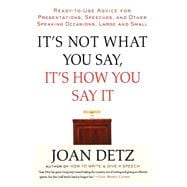
What is included with this book?
| Acknowledgments | xiii | ||||
| Preface | xv | ||||
| Section One What You Say | 1 | (4) | |||
| Section Two How You Say It | 5 | (100) | |||
|
7 | (3) | |||
|
10 | (4) | |||
|
14 | (6) | |||
|
20 | (9) | |||
|
29 | (2) | |||
|
31 | (5) | |||
|
36 | (65) | |||
|
101 | (4) | |||
| Section Three When You Say It | 105 | (20) | |||
|
107 | (9) | |||
|
116 | (1) | |||
|
117 | (1) | |||
|
117 | (1) | |||
|
118 | (1) | |||
|
118 | (1) | |||
|
119 | (2) | |||
|
121 | (2) | |||
|
123 | (2) | |||
| Section Four Where You Say It | 125 | (14) | |||
|
127 | (1) | |||
|
128 | (1) | |||
|
129 | (2) | |||
|
131 | (1) | |||
|
132 | (2) | |||
|
134 | (1) | |||
|
135 | (4) | |||
| Section Five Who Says It, and Who Is Listening? | 139 | (18) | |||
|
141 | (1) | |||
|
141 | (3) | |||
|
144 | (9) | |||
|
153 | (4) | |||
| Section Six Who Else Could Say It for You? | 157 | (10) | |||
|
159 | (3) | |||
|
162 | (1) | |||
|
163 | (1) | |||
|
163 | (4) | |||
| Section Seven Was Your Speech a Success? | 167 | (24) | |||
|
169 | (1) | |||
|
170 | (1) | |||
|
171 | (2) | |||
|
173 | (1) | |||
|
174 | (1) | |||
|
175 | (4) | |||
|
179 | (1) | |||
|
180 | (1) | |||
|
181 | (1) | |||
|
182 | (3) | |||
|
185 | (1) | |||
|
186 | (5) | |||
| Section Eight Appendix---Useful Books, Websites, and Professional Organizations | 191 | (28) | |||
|
193 | (22) | |||
|
215 | (1) | |||
|
215 | (4) | |||
| Index | 219 |
The New copy of this book will include any supplemental materials advertised. Please check the title of the book to determine if it should include any access cards, study guides, lab manuals, CDs, etc.
The Used, Rental and eBook copies of this book are not guaranteed to include any supplemental materials. Typically, only the book itself is included. This is true even if the title states it includes any access cards, study guides, lab manuals, CDs, etc.
Chapter One
The title of this book reads It's Not What You Say, It's How You Say It . But I have a confession: That might be a slight exaggeration. Because "what you say" does matter ... it just doesn't tell the whole story.
Let me explain.
Maybe you have to run a community fund-raiser, or meet face-to-face with a sales prospect, or handle a tough job interview. Maybe you have to give a short presentation to a few colleagues at a department meeting, or give a big speech at a professional conference.
Whether you're talking to one person or a thousand, you certainly need a message. And that message must be targeted to your listeners' needs.
Before you decide "what to say," ask yourself these important questions:
(1) What do they want to hear from me?
(2) What do they need to hear from me?
(Pamela Harriman, former U.S. ambassador to
France, once defined leadership as "the ability to
tell people not what they want to hear, but what
they need to know.")
(3) What do they already know about this topic--and where did they get their information?
(4) What misconceptions do they have?
(5) What problems do they face--and how did those problems develop?
(6) What solutions have they already tried?
(7) What message would be most comfortable?
(8) What message would be most troubling?
(9) What information could save them money?
(10) What information could save them time?
(11) What changes would I suggest they make?
(12) What recommendations could they put into practice most easily?
(13) What advice would be welcome?
(14) What advice would be resented?
(15) What perspective can I bring to their unique situation?
(16) And, perhaps the most important question: What
can I say to them that no one else could say as
effectively?
Once you ask yourself these basic questions, you should have a pretty good idea of what to say. And that's important, because you certainly need a message.
But good presentations demand more than a message. And that's why this chapter--the "content" chapter--is the shortest in the whole book. As you will soon see, good communication isn't just "what you say," it's how you say it.
Excerpted from IT'S NOT WHAT YOU SAY, IT'S HOW YOU SAY IT by Joan Detz. Copyright © 2000 by Joan Detz. Excerpted by permission. All rights reserved. No part of this excerpt may be reproduced or reprinted without permission in writing from the publisher.